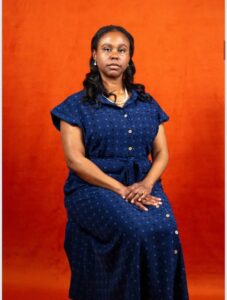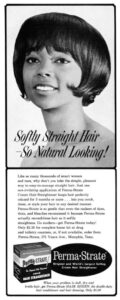Linda Villarosa, a contributing writer for The New York Times magazine, interviewed dozens of people, including scientists, government officials and legal plaintiffs, for this article.
The phone rang incessantly in Dr. Tamarra James-Todd’s office at Harvard’s T.H. Chan School of Public Health. “I’m sorry,” she said, excusing herself for the third time. “It’s happening a lot,” she explained after pausing to take another call, “with the F.D.A. thing.”
James-Todd, an associate professor of environmental reproductive epidemiology, is a pioneer who has conducted or been a co-author of nearly 70 scientific investigations over the past 20 years to establish the connection between the chemicals in hair products that generations of Black women have used to straighten their hair and the reproductive health racial disparities that scientists have struggled to explain for decades. And on that day last October, she was receiving calls because the Food and Drug Administration had announced a proposal for a ban on the use of formaldehyde as an ingredient in hair relaxers, citing its link to cancer and other long-term adverse health effects.
Her early and sustained interest has also inspired other scientists — most of them Black women like her — to add questions about the use of hair relaxers and other products to large longitudinal studies with tens of thousands of subjects as they pursue explanations for these racial disparities. The scientists are driven by their own intimate experience: As children, they sat in salon chairs or in kitchens having chemical relaxers, colloquially called “creamy crack,” applied to their hair as they waited for it to go from “kinky” to smooth and silky as the products promised. Decades later, they still recall the harsh smell and the sensation of their scalps being aflame. “I go all the way back to: I was right,” James-Todd said. “That stuff that was burning on my head — it wasn’t safe.”

studying the chemicals in hair products and their links to
reproductive-health disorders in Black women for 20
years.
The research has finally begun to bear fruit: A robust body of scientific evidence has now shown that straighteners and other hair products marketed to Black girls and women have been linked to endocrine-disrupting substances associated with the early onset of menstruation and many of the reproductive health issues that follow, from uterine fibroids, preterm birth and infertility to breast, ovarian and uterine cancer. Many of these hormone health-related problems are more common in Black women than in other women, including an aggressive form of breast cancer that contributes to a death rate from the disease that is 28 percent higher than the rate for white women.
The evidence took a drastic turn in October 2022 when the Sister Study, which was led by the National Institute of Environmental Health Sciences and followed a cohort of nearly 34,000 women, found that those who frequently used chemical hair-straightening products, a majority of whom were Black women, were two and a half times as likely to develop uterine cancer as those who did not use the products. Uterine cancer is the most common cancer of the female reproductive system, and the most aggressive subtypes have been on the rise since 2000 — especially among Black women.
The Sister Study, and several studies that followed, including work from James-Todd’s lab, represents a significant step forward, offering compelling scientific evidence of what has been long suspected. Over the past year and a half, this research has prompted lawsuits involving nearly 9,000 plaintiffs across the country and at least the promise of new action from the federal government.
“I think we’re sitting in a moment in time,” James-Todd told me in her office as her phone continued to ring in the days after the news of the F.D.A. proposal, “where — even if it’s just for a second, because I’m not sure how long it’s going to last — we know that there’s value in doing health-disparities research. We know that there is value in focusing in on the health of women of color.” Until recently, she said, “it wasalways the sidelined topic.”
But now the momentum was palpable: “There’s a real passion to do this work. And I do think it’s brought on by the coming together of policies, holding companies accountable through legal actions, holding the government accountable.” If and when the F.D.A. removes formaldehyde from relaxers, that ban would not address the fact that the products most often used by Black women remain vastly underregulated and, until recently, insufficiently studied. Many of the substances they contain are prohibited in other countries. The European Union regulates more than 1,300 ingredients for use in cosmetics; the F.D.A. prohibits or restricts only nine ingredients that have been proved harmful to human health. In the United States, manufacturers, not the government, are nominally responsible for ensuring product safety. Chemical relaxers and other beauty products are marketed similarly in Europe and the United States, though they contain different active ingredients given Europe’s much stricter regulation. In fact, hair relaxers marketed to children in the United States have been found to contain the highest levels of five of the chemicals prohibited in the European Union.
Under the lax oversight by the American government, even the package labeling can’t be trusted. A 2018 scientific report conducted by Silent Spring Institute, an environmental-health research organization, was built on a list supplied by James-Todd of 18 different hair products marketed to and used by Black women; Silent Spring found dozens of chemicals that can disrupt hormones — but 84 percent of the toxic ingredients weren’t listed on the packaging. Several studies have found higher levels of endocrine-disrupting chemicals in the urine of Black women compared with that of white women.
This means that even as the evidence is increasingly harder to ignore or deny, consumers remain shockingly unprotected, leading to an entirely preventable continuing public-health crisis. Most of the studies have been published in science journals that never reach the general public. Many Black people have quietly wondered for years whether hair relaxers were safe, but burning scalps and even hair loss have been normalized as the price of desirably straight hair.

products helped build an exploding midcentury market by reaching Black women in the magazines they read.
In his 2009 documentary “Good Hair,” Chris Rock memorably showed an aluminium soda can submerged in a beaker of sodium hydroxide, or lye, which was until fairly recently a main ingredient in relaxers: After four hours, it had disintegrated. In the 2022 Hulu series “The Hair Tales,” Oprah Winfrey recalled leaving a salon
with a severely burned scalp after a relaxer treatment in 1977. Every time she combed or washed her hair, clumps of it fell out. Because of stories like these, and as Black women have increasingly embraced natural styles, sales of hair relaxers have declined from $71 million in 2011 to $30 million in 2021. But that is still a sizable market; a 2020 analysis found that 10.5 million Americans used home hair permanents and relaxers, and clients are still having their hair relaxed at salons. An estimated 89 percent of Black women in the United States have used hair relaxers at least once, according to a 2020 study co-authored by James-Todd. In other words, an overwhelming majority of Black women have straightened their hair using chemicals at some point in their lives, often beginning in childhood.
For this article, reported over more than a year, I interviewed dozens of people: scientists at universities, government agencies and nonprofit health organizations; subjects taking part in medical studies; plaintiffs in lawsuits; politicians; historians; activists; and lawyers. I created an extensive database of studies, articles and reports, dating to the 1990s, about Black hair products, hormonally related health issues and their intersection, ranging from a tiny observational study with only four subjects to longitudinal studies with tens of thousands of participants that compare risk factors and health outcomes over decades.
The question remains: Why are hair products marketed aggressively to Black women still on the market with so little oversight, even amid growing documentation of the extent of the harm? When I asked an F.D.A. spokeswoman why the endocrine-disrupting chemicals called phthalates are not banned for use in cosmetics, including hair relaxers, in the United States as they are in Europe, she replied in an email that “at the present time, the F.D.A. does not have evidence that phthalates as used in cosmetics pose a safety risk.”
“I’m not saying that more research isn’t needed, but there’s study after study,” James-Todd said. “At some point you have evidence enough tom start making recommendations that people reduce their use of these products or don’t use them at all.”
“I hate to say it,” she added, “but in the U.S., we don’t care. It’s about the money.” Black people, and particularly Black women, have had a centuries-old, complicated relationship to our hair. It has been a source of style, creativity and pride, as well as pain, insult and discrimination. In the early 1900s, as hundreds of thousands of Black people migrated from the South to cities in the North to find employment in factories or as washerwomen and maids working in white homes, Black women made damaging efforts to straighten their hair in order to be perceived as presentable and professional rather than unsophisticated and “country”.
Madam C.J. Walker became one of the first Black American millionaires by developing the Walker System, a shampoo-press-and-curl method that used a heated iron comb to straighten Black hair. She also started the Lelia College of Beauty Culture, creating a career path that allowed thousands of Black women tobecome hair “culturists,” rather than domestics, and tens of thousands more to work in her factory or sell her products. My grandmother migrated from Mississippi to Chicago in the late 1920s and refused to work as a domestic like her sisters. She couldn’t afford Walker’s school and instead went to Miss Lydia’s Beauty College, a less expensive knockoff. (I still remember the neighborhood women, decades later, sitting in our kitchen to get their hair shampooed, pressed and curled; the sight of the stovetop flames licking the hot comb as it went from black to red-hot; the acrid smell of burning hair.)
The African American inventor Garrett A. Morgan has been credited with developing the first chemical relaxer, but the products would not explode into wide use until the 1950s, when George E. Johnson, a Chicago chemist, invented a more effective formula using sodium hydroxide as the active ingredient. It worked by breaking down the protein structure of the hair in order to loosen the natural curls. Johnson and his wife, Joan, brought Ultra Sheen, a relaxer targeted to Black women, to the market in 1957, and it became a sensation.
Johnson Products became the first Black-owned company to be listed on the American Stock Exchange, controlling 60 percent of the Black hair-care market by 1975. Its success attracted a flood of competitors, most of them other Blackowned companies headquartered in Chicago. Johnson’s biggest rivals were Carson Products, the maker of the enormously popular Dark & Lovely, and SoftSheen, the manufacturer of Care Free Curl. But even as these Black companies were capitalizing on a societal standard, a counterculture was emerging.
The Black Power Movement of the 1960s and ’70s fostered a Black Is Beautiful ethos and a new silhouette and symbol: the Afro. Even so, the mainstream pressure to wear straight hair remained pervasive, and my grandmother stopped speaking to my mother, my sister and me for several weeks in the mid-’70s when we went natural with Angela Davis-style Afros. Even as Black hair was becoming increasingly political, many Black consumers continued using relaxers and began complaining that their scalps were being burned and their hair was thinning and breaking because of the harshness of lye-based relaxers. In 1975, the Federal Trade
Commission demanded that Johnson put warning labels on lye-based products. By the mid-1980s, many manufacturers had removed sodium hydroxide from its relaxer ingredient list. Most replaced it with a milder chemical, calcium hydroxide. The products were labeled “no lye,” and the companies added marketing descriptors like “gentle,” “natural,” “healthy,” “nourishing” and “conditioning.” In 1979, Revlon, the first non-Black company to set its sights on the lucrative Black hair-care market, introduced a relaxer cream it called Realistic. Positioning itself as superior to the Black-owned companies, it branded its product “the first hair relaxer good enough to be called Revlon.”
In 1998, Carson Products bought Johnson Products for $70 million; in 2000, the French cosmetic company L’Oréal acquired Carson. L’Oréal also snapped up SoftSheen, paying a combined price estimated at $370 million for the two companies and absorbing 20 percent of the Black hair-care market. The industry was booming — and selling chemically relaxed hair to a new generation with kits that were themselves objects of desire, decorated in pastels, flowers, butterflies and photos of smiling little-girl models with their hair hanging in glossy dark sheets.
James-Todd grew up during this boom, and she remembers her Black-girl rite of passage at 8 years old: getting her hair relaxed for the first time. As she sat in the chair at a salon in Kansas City, Mo., in 1987, with thick white goo covering her head, she imagined herself with the long, straight hair she’d seen on family members.
Then her scalp began to burn. As she squirmed, she recalls, her mother told her: “Hold still. This is how it’s supposed to feel.” That evening, as she brushed her hair, it fell out in handfuls.
As it turned out, several of the young models who became mini-celebrities as the faces of Pretty-n-Silky, Beautiful Beginnings, Just for Me and other relaxers targeted to children would reveal decades later that they never used the products themselves — or had long ago stopped chemically relaxing their hair — and instead
straightened their hair with heat.Many Black women do use heat to straighten their hair, by blow drying, flat ironing or pressing the hair in salons or at home with instruments more advanced than the hot comb my grandmother used. But when the hair gets wet — when it is washed or during a rainstorm, in a swimming pool or after a vigorous workout — it reverts to its natural state. My mother didn’t learn to swim until her 70s, because as a child she wasn’t allowed to get her hair wet; it would “go back,” and my grandmother would have to start the time-consuming straightening process all over again.
Working women and busy mothers often feel that they don’t have the time or the money to spend on that laborious routine, making chemical relaxers an easier and much more affordable option. That helps explain why a vast majority of Black women have used relaxers at some point in their lives.
Straight hair continues to be the dominant standard of beauty for Black women, from working-class women to those in government and corporate America to celebrities to even someone in the White House. Michelle Obama said in 2022 that she felt she had to straighten her hair while serving as first lady, rather than wear a natural style, because America was just getting used to having a Black man in the Oval Office and a Black family in the White House — and not without resistance. “Nope,” she said. “They’re not ready for it.”
Gatekeepers News is not liable for opinions expressed in this article, they’re strictly the writer’s







